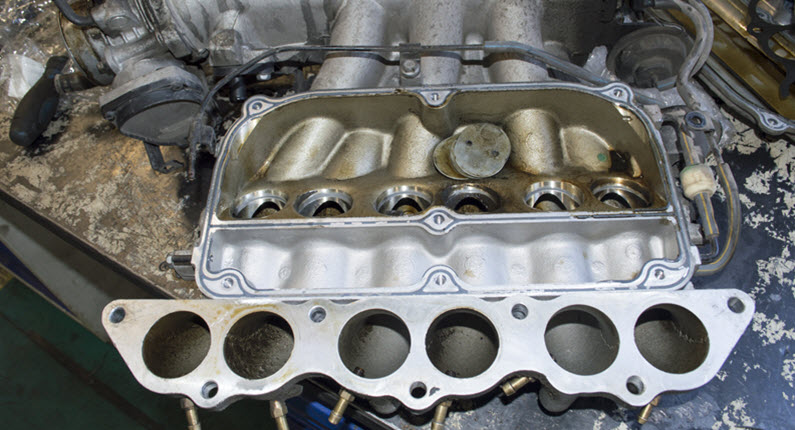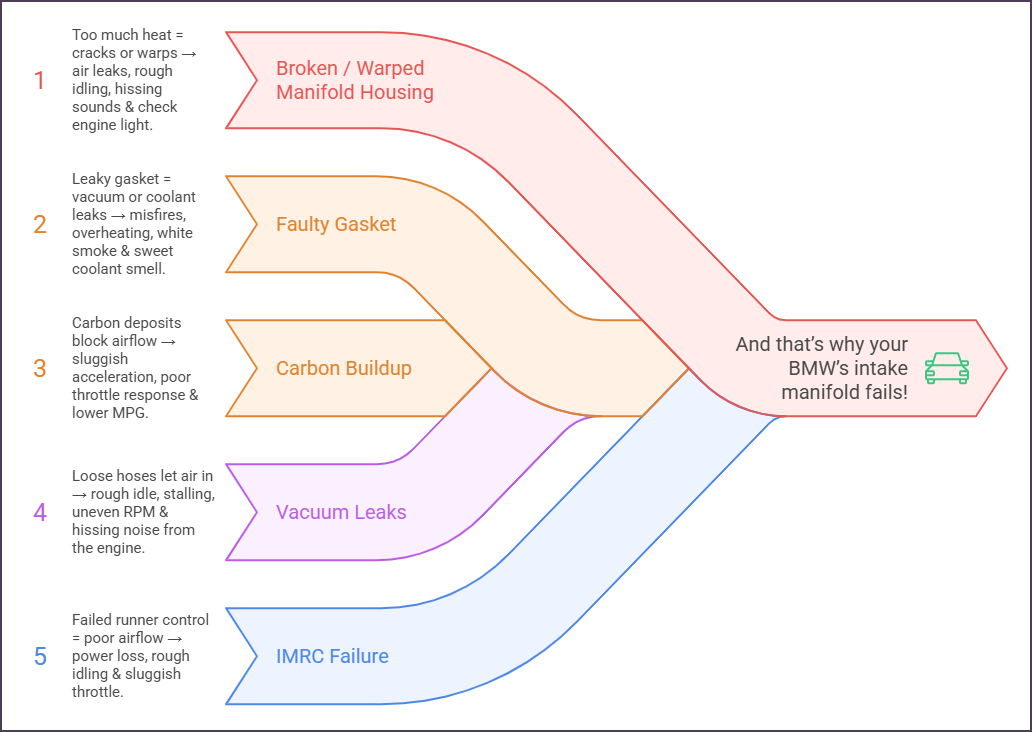Your BMW is a beast on the road, impressing you with its optimal performance, alongside its beauty and comfort. However, despite having such a tough personality, its various auto parts may wear out over time, impacting the overall driving experience and frustrating you at the end of the day. One such internal engine part is the intake Manifold, which is responsible for delivering the correct amount of air into the combustion chambers to maintain the peak engine operation and ignition. It plays a primary role in the engine and carries out optimal combustion. When it starts failing, you may experience significant power loss, low fuel efficiency, and typical engine issues. Thus, it’s crucial to know the common factors that hamper your BMW’s intake manifold, along with their warning signs, so that you can address the issue early.
Reasons Behind Your BMW’s Intake Manifold Failure And Its Symptoms
- Broken or Warped Manifold Housing: Constant and excessive engine heat eventually affects all its internal components, and the intake manifold housing is no exception. So, when the housing becomes warped or develops cracks or holes, the air starts escaping through the leaks, causing the engine to work roughly. As a result, you may see a rough engine idling, feel a sudden drop in power, and hear a loud, unusual hissing noise, especially from the engine area. Apart from these symptoms, you may also notice a glowing or flickering check engine light, as the sensor readings detect abnormal airflow and send the data to the ECU to activate the alert. However, without proper attention, it can result in significant engine wear due to incorrect air-fuel mixture, generating excessive heat.
- Faulty Gasket: The intake manifold is sealed to the engine block by the intake manifold gasket, which restricts the air and coolant from leaking out. Thus, when the gasket starts to wear out, it can give rise to vacuum leaks, which ultimately cause engine misfires, sluggish acceleration, and poor fuel economy. Moreover, a leaky gasket seeping out coolant can lead to overheating, emitting white fumes from the exhaust system. Plus, you may also smell a sweetish odor inside your car cabin due to the escaping coolant. Along with these warning indicators, you may also see the check engine light or other engine overheating alert messages on the display, notifying you about this nuisance.
- Carbon Buildup: Over time, due to improper combustion and EGR (Exhaust Gas Recirculation) processes, carbon accumulates on the intake manifold, which typically restricts airflow, reducing engine power and making the throttle unresponsive. This results in symptoms such as rough idling, poor acceleration, and reduced fuel efficiency, along with erratic engine behavior during acceleration and the activation of the check engine light. Additionally, these issues may also escalate over time, potentially causing engine misfires or sensor errors related to airflow.
- Vacuum Leaks: When hoses break or connections loosen, unintended air enters the intake manifold, causing vacuum leaks. In this case, the air-fuel mixture eventually becomes disrupted, and ultimately, you experience engine stalling, rough idling, and fluctuating engine RPM. Apart from these warning signs, you may also notice diminished engine performance as well as could hear loud and abnormal sucking or hissing noises, especially from the engine compartment. Diagnostic error codes for these leaks also include the codes related to fuel system faults.
- Problematic Intake Manifold Runner Control (IMRC): The primary role of the IMRC is to control the airflow, allowing the engine to work optimally and efficiently. Hence, with a failed IMRC, you may observe sluggish throttle response, rough idling, and overall power loss, particularly at low or moderate engine revs. This usually occurs due to stuck or damaged runners, which may also have common indicators like poor acceleration, the engine struggling to run, and a glowing or blinking check engine light. In some cases, the engine may produce loud sounds or perform roughly, which definitely results from an ineffective airflow process.
What Makes Us The Top Choice to Diagnose Your BMW’s Intake Manifold Issues?
Situated in the heart of Marin, Heynneman European can be your ultimate destination for addressing BMW intake manifold defects in San Rafael, CA. Regardless of whether it’s suffering from carbon buildups or broken housing, our highly skilled technicians are proficient enough to thoroughly troubleshoot all issues and take the necessary steps using high-end tools, depending on the severity of the damage. If the intake manifold seems damaged completely, we prefer replacing it with a new OEM part suitable for your BMW model to keep your vehicle performing at its best. Therefore, without further delay, visit us today and take advantage of the excellent services that your luxury car deserves.


